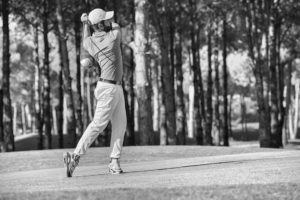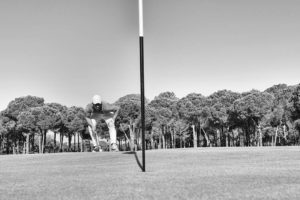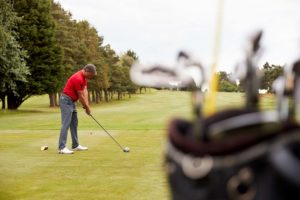As I progressed with playing golf, how to address a golf ball with an iron efficiently has been a recurring question in my mind.

In my earlier days, I thought that the key to getting a par is a perfect swing–and it is. However, what I didn’t think of at the time was the process behind it.
Slowly, after years of training and practice, I figured out that the address position varies for every different club.
How to Address a Golf Ball with an Iron
Improving your address can go a long way. For me, it keeps everything in the right spot when I perform my swing. So what exactly is ‘address’ in golf?
‘Address’ in golf describes the stance and how the player places the clubhead behind the ball.
‘Address’ is essential in preparing for your hit. Unfortunately, many golfers often overlook this basic fundamental. Now that you know what is an iron golf club,
Here are some tips on how you can address a golf ball with an iron properly:
Golf Setup Alignment
When addressing the golf ball with an iron, start by shifting the address alignment. Position your body parallel to your target line. It ensures that the golf ball is on the target line and not your body.
You can use an alignment rod (or a spare club if you don’t have a rod) to measure the line accurately.
-
Ball Position
If you have previously used a driver, you may compare how to swing irons vs driver in golf. With a driver, you position the ball forward.
Unlike at the address with an iron, where the ball position must be in the center between your feet. The length of your iron club and how high you want the flight also determine the position of the ball.
If you want the flight to be high, you can position the ball slightly forward of the center. To hit the ball down, you can move it slightly backward from the center.
-
Long Irons
Place the ball direct (front) to your foot to hit the ball from the bottom. How to play long irons golf? Make a backswing arc with less divot when you stroke.
Back to the comparison on how to swing irons vs driver in golf, this is unlike using drivers where you focus on the center of the golf ball.
-
Medium Irons
Since this length has a slightly flat angle, it’s best to position the ball while directing the target-side.
-
Short Irons
Placing the ball in the middle allows a short iron to impact the ball first in an upright angle.
Note that, as the length of the club you use increases, the position of the ball progressively towards the front foot.
Proper Stance and Balance
The way you stand your foot allows you to pivot your hip when you perform your swing. Your stance width must be 20 to 40 degrees. This angle enhances your body’s rotation around your target.
So how to swing irons vs driver in golf? You have to twist your body and shift your weight between your feet when you make a swing using a driver.
In irons, You have to evenly balance your weight on your feet–not your toes. The foot alignment and balance may also depend on the length of your iron.
-
Long Irons
There should be a 4-inch space for a long iron stance. The back of your legs must relatively carry 60 percent of your weight.
-
Medium Irons
To hit the ball straight with a medium iron, try to align your feet with your shoulder. For the balance, ensure that the weight is half or equal to each foot.
-
Short Irons
For a short iron stance, there should be a 2-inch space between your feet. Your weight should then be at least 60 percent on the foot of your target side.
Iron Golf Club Position
If you’re training how to address a golf ball with an iron, it’s essential to know the proper positioning of the clubhead. The lie of the golf club impacts your overall setup position.
Instead of pressing the clubhead firmly, the key is to set the clubhead on the grass surface gently and to push the shaft forward slightly.
-
Posture
Once you’ve ensured that your club is on the proper alignment to the ground surface, you now have to fit your posture into the handle.
Take note that you should address the golf club without moving the clubhead from this position. Doing this will avoid interference with the shaft’s angle.
The key is: BE TALL! Setting up your position at your maximum height is crucial in addressing the golf ball.
-
Knees
Bend your knees slightly. It should not be locked straight or bent very low. Your stance should allow your hips and shoulders to rotate with ease.
-
Spine
Your spine angle should appear straight. You can do this by tilting your upper body forward at address. Also, there should be enough distance between your hands and your hips.
However, take note that it should not create so much tension in the lower back. Thus, your back shouldn’t appear rounded, nor your buttocks should stick out.
-
Shoulders
Your shoulders should not perfectly align to the ground. Angle your shoulders slightly, with the other side stoop lower.
-
Chin
Finally, extend your child in a position that would not disrupt your swinging.
What is an Iron Golf Club?
As you may now know, each type of club is equivalent to different materials.
And, iron is one of the most common types of golf clubs. As I took note of this, I naturally started asking myself how do golf irons work.
Since we’re going to talk about how to address a golf ball with iron in this guide, let’s define what is an iron golf club first.
As its name suggests, iron golf clubs are metal clubheads with a flat angled face. For easier access, it features a short shaft and an upright lie angle compared to wood club variants.
You can use iron clubs to make a variety of shots around the course. That’s why you may notice that most golfers carry a lot of iron clubs in their bags (usually between 7 to 11 iron clubs).
How Do Golf Irons Work?
Now, you may be asking how do golf irons work. Iron golf clubs have numbers ranging from 1 to 9.
These numbers correspond to their relative loft angle on the clubface within a matched set. The most commonly used iron clubs are from the 3 to 9 range.
If you’re wondering what comes after 9, these irons with higher loft angles are what is known as the wedges. The categorization of irons is according to their intended distance.
It also determines their shaft length and their difficulty to use in hitting the ball.
- 2 to 4: long irons
- 5 to 7: medium irons
- 8 to 9: short irons
To understand better how do golf irons work,
Here is a comparison between lower iron numbers and higher iron numbers:
- Lower the golf club number, the less sharp the angle on the face. Hence, the golf ball will travel lower but with more distance.
- The higher the golf club number, the more intense the angle on the face. Accordingly, the golf ball will travel at a height but with a shorter distance.
How to Play Long Irons Golf
Long irons (or the 1 to 4 irons) are the iron clubs with the longest shafts and the lowest lofts. Players usually use long irons to hit long distances with a lower launch angle.
How to play long irons golf? You can use it from the fairway or rough. They are also convenient to use for trouble spots like punching out.
What is a 1 Iron in Golf?
Why is 1 iron in golf is barely mentioned in the section earlier? The reason is that carrying a 1 iron or even 2 iron is not standard anymore.
As it is the longest iron and also the lowest lofted, it makes it the most difficult club to hit.
It also has the least surface area on its face. So, don’t be surprised if most golfers, even professionals, don’t have it on their bags.
How to Sharpen Golf Irons
Now that you know how to address a golf ball with an iron, it’s also essential to understand how you can maintain your club’s groove.
Sharp grooves allow you to produce spin. It can also result in more precise shots. There are two ways how to sharpen golf irons: use a groove sharpener or go to a professional.
This video by Rick Shiels Golf may help you get started with how to sharpen golf irons personally.
It may cost more than doing it with a groove sharpener, but contacting a professional to sharpen your golf iron will ensure that your club is safe from damage.
Go Practice
Practicing how to address a golf ball with an iron consistently will allow you to make better swings and hits.
This knowledge made me invest more time in practicing the slight adjustments that I need to do when I address the golf ball.
Soon enough, you may not even notice that you have improved and it has become natural to your play.
Practice makes perfect!
More Information
Last Updated on December 4, 2023 by Paul Roger Steinberg





